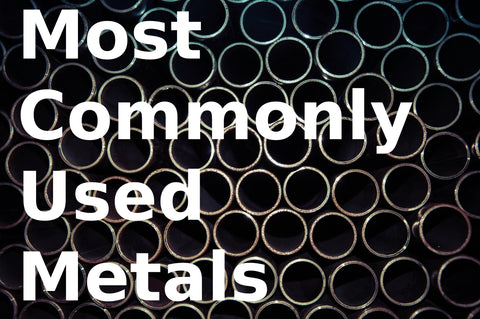MOTHER'S DAY SALE! Up To 50% OFF & 15% OFF Code: MOM15 + Free Shipping |Track My Order
Most Commonly Used Metals

Most Commonly Used Metals
Metals have been an integral part of human civilization for thousands of years, shaping industries, technologies, and cultures. From ancient civilizations forging bronze weapons to modern skyscrapers constructed with steel frames, metals have played a crucial role in our everyday lives. In this blog, we'll delve into some of the most commonly used metals, their properties, applications, and significance in various fields.
Iron
Iron, one of the most abundant elements on Earth, has been used by humans for millennia. Its versatility, strength, and ability to be easily shaped make it indispensable in various industries. From structural beams in buildings to machinery and tools, iron is everywhere. When combined with carbon, it forms steel, a material renowned for its strength and durability. Steel finds applications in construction, automotive manufacturing, shipbuilding, and countless other sectors.
Aluminum
Aluminum, lightweight and corrosion-resistant, has become ubiquitous in modern life. Its low density makes it ideal for aerospace applications, where weight reduction is critical. Aluminum alloys are also extensively used in automotive manufacturing, packaging, electronics, and construction. The recyclability of aluminum further adds to its appeal as a sustainable material.
Copper
Copper, valued for its excellent conductivity and malleability, has been prized since ancient times. Its conductivity makes it essential in electrical wiring, telecommunications, and electronics. Copper alloys, such as brass and bronze, offer additional properties like corrosion resistance and aesthetic appeal, making them valuable in plumbing fixtures, musical instruments, and decorative arts.
Zinc
Zinc, often overshadowed by other metals, plays a vital role in various industries. Its anti-corrosive properties make it a crucial component in galvanizing steel to prevent rusting. Zinc alloys, such as zinc-aluminum (ZA) and zinc-nickel (Zn-Ni), find applications in automotive parts, die casting, and battery manufacturing.
Lead
Despite growing concerns about its toxicity, lead remains a significant metal in certain applications. Its high density and resistance to corrosion make it valuable in radiation shielding, battery manufacturing, and soldering. However, efforts to minimize lead exposure have led to the development of alternative materials in many industries.
Titanium
Titanium, known for its strength-to-weight ratio and corrosion resistance, finds applications in aerospace, medical implants, sporting goods, and high-performance engineering. Although more expensive than traditional metals like steel and aluminum, titanium's exceptional properties justify its use in critical applications where reliability is paramount.
Conclusion
The world of metals is vast and diverse, with each metal offering unique properties and applications. From the ancient era to the modern age, metals have shaped human civilization and propelled technological advancements. As industries continue to innovate and evolve, the demand for metals will persist, driving further exploration and utilization of these essential materials. Whether it's building infrastructure, powering electronics, or exploring outer space, metals remain indispensable in our quest for progress and innovation.
